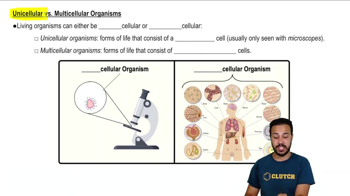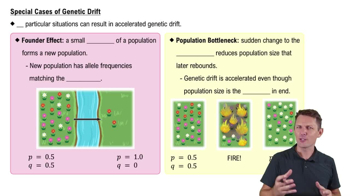The area of science that studies life and its processes is called:
Table of contents
- 1. Introduction to Biology2h 42m
- 2. Chemistry3h 40m
- 3. Water1h 26m
- 4. Biomolecules2h 23m
- 5. Cell Components2h 26m
- 6. The Membrane2h 31m
- 7. Energy and Metabolism2h 0m
- 8. Respiration2h 40m
- 9. Photosynthesis2h 49m
- 10. Cell Signaling59m
- 11. Cell Division2h 47m
- 12. Meiosis2h 0m
- 13. Mendelian Genetics4h 44m
- Introduction to Mendel's Experiments7m
- Genotype vs. Phenotype17m
- Punnett Squares13m
- Mendel's Experiments26m
- Mendel's Laws18m
- Monohybrid Crosses19m
- Test Crosses14m
- Dihybrid Crosses20m
- Punnett Square Probability26m
- Incomplete Dominance vs. Codominance20m
- Epistasis7m
- Non-Mendelian Genetics12m
- Pedigrees6m
- Autosomal Inheritance21m
- Sex-Linked Inheritance43m
- X-Inactivation9m
- 14. DNA Synthesis2h 27m
- 15. Gene Expression3h 20m
- 16. Regulation of Expression3h 31m
- Introduction to Regulation of Gene Expression13m
- Prokaryotic Gene Regulation via Operons27m
- The Lac Operon21m
- Glucose's Impact on Lac Operon25m
- The Trp Operon20m
- Review of the Lac Operon & Trp Operon11m
- Introduction to Eukaryotic Gene Regulation9m
- Eukaryotic Chromatin Modifications16m
- Eukaryotic Transcriptional Control22m
- Eukaryotic Post-Transcriptional Regulation28m
- Eukaryotic Post-Translational Regulation13m
- 17. Viruses37m
- 18. Biotechnology2h 58m
- 19. Genomics17m
- 20. Development1h 5m
- 21. Evolution3h 1m
- 22. Evolution of Populations3h 53m
- 23. Speciation1h 37m
- 24. History of Life on Earth2h 6m
- 25. Phylogeny2h 31m
- 26. Prokaryotes4h 59m
- 27. Protists1h 12m
- 28. Plants1h 22m
- 29. Fungi36m
- 30. Overview of Animals34m
- 31. Invertebrates1h 2m
- 32. Vertebrates50m
- 33. Plant Anatomy1h 3m
- 34. Vascular Plant Transport1h 2m
- 35. Soil37m
- 36. Plant Reproduction47m
- 37. Plant Sensation and Response1h 9m
- 38. Animal Form and Function1h 19m
- 39. Digestive System1h 10m
- 40. Circulatory System1h 49m
- 41. Immune System1h 12m
- 42. Osmoregulation and Excretion50m
- 43. Endocrine System1h 4m
- 44. Animal Reproduction1h 2m
- 45. Nervous System1h 55m
- 46. Sensory Systems46m
- 47. Muscle Systems23m
- 48. Ecology3h 11m
- Introduction to Ecology20m
- Biogeography14m
- Earth's Climate Patterns50m
- Introduction to Terrestrial Biomes10m
- Terrestrial Biomes: Near Equator13m
- Terrestrial Biomes: Temperate Regions10m
- Terrestrial Biomes: Northern Regions15m
- Introduction to Aquatic Biomes27m
- Freshwater Aquatic Biomes14m
- Marine Aquatic Biomes13m
- 49. Animal Behavior28m
- 50. Population Ecology3h 41m
- Introduction to Population Ecology28m
- Population Sampling Methods23m
- Life History12m
- Population Demography17m
- Factors Limiting Population Growth14m
- Introduction to Population Growth Models22m
- Linear Population Growth6m
- Exponential Population Growth29m
- Logistic Population Growth32m
- r/K Selection10m
- The Human Population22m
- 51. Community Ecology2h 46m
- Introduction to Community Ecology2m
- Introduction to Community Interactions9m
- Community Interactions: Competition (-/-)38m
- Community Interactions: Exploitation (+/-)23m
- Community Interactions: Mutualism (+/+) & Commensalism (+/0)9m
- Community Structure35m
- Community Dynamics26m
- Geographic Impact on Communities21m
- 52. Ecosystems2h 36m
- 53. Conservation Biology24m
1. Introduction to Biology
Introduction to Biology
Problem 9
Textbook Question
What characteristic distinguishes true multicellularity from colonies of cells?
 Verified step by step guidance
Verified step by step guidance1
Understand the concept of multicellularity: True multicellularity refers to organisms composed of multiple cells that are specialized and interdependent, working together to perform specific functions.
Compare with colonies of cells: Colonies are groups of cells that live together but do not exhibit significant specialization or interdependence. Each cell in a colony can often survive and function independently.
Identify the key characteristic: True multicellularity is distinguished by cellular differentiation, where cells take on specialized roles (e.g., muscle cells, nerve cells) and cannot survive independently outside the organism.
Consider interdependence: In true multicellularity, cells rely on each other for survival and proper functioning, forming a cohesive organism. In contrast, cells in a colony are loosely associated and can often separate without harm.
Summarize the distinction: The defining characteristic of true multicellularity is the presence of specialized, interdependent cells that work together as part of a single organism, unlike colonies where cells remain largely independent.
 Verified video answer for a similar problem:
Verified video answer for a similar problem:This video solution was recommended by our tutors as helpful for the problem above
Video duration:
1mPlay a video:
Was this helpful?
Key Concepts
Here are the essential concepts you must grasp in order to answer the question correctly.
True Multicellularity
True multicellularity refers to an advanced form of organization where cells are specialized and work together to perform distinct functions. In true multicellular organisms, cells communicate and coordinate their activities, leading to the development of complex structures and systems, such as tissues and organs, which are essential for survival and reproduction.
Recommended video:
Guided course

Unicellular vs. Multicellular
Cell Specialization
Cell specialization is the process by which generic cells develop into distinct cell types with specific functions. In multicellular organisms, this specialization allows for the division of labor, where different cells perform unique roles, such as muscle contraction, nutrient absorption, or immune response, contributing to the overall efficiency and adaptability of the organism.
Recommended video:

Special Cases of Genetic Drift
Colony vs. Multicellularity
Colonies of cells consist of groups of individual cells that live together but do not exhibit the level of integration seen in true multicellular organisms. In colonies, cells may share resources and provide some level of cooperation, but they remain largely independent and lack specialized functions, which distinguishes them from the highly coordinated and interdependent nature of true multicellularity.
Recommended video:
Guided course

Unicellular vs. Multicellular

 1:28m
1:28mWatch next
Master Introduction to Biology Channel with a bite sized video explanation from Jason
Start learningRelated Videos
Related Practice
Multiple Choice
17582
views
408
rank
